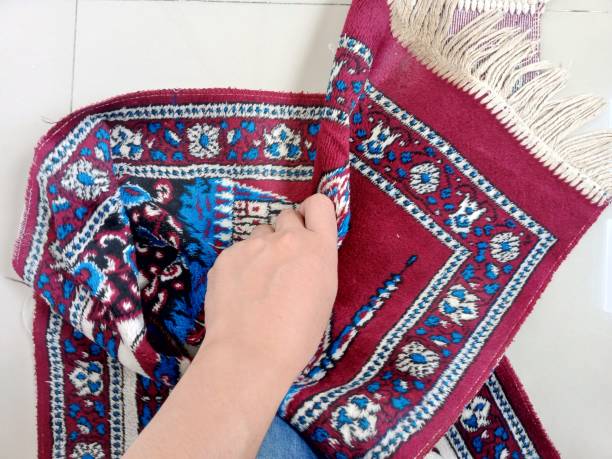Can your Persian carpet benefit from a deep cleaning? Persian rugs can last for a lifetime. This means that they are subject to damage from pets, foot traffic, and spills. Knowing how to clean a Persian rug is very useful. We’ve put together a guide to help you clean your handmade rug, from deep cleaning to spot cleaning.
How To Deep Clean A Persian Rug
Persian rugs can last for many years, but only if you take care of them. To keep your Persian rugs in perfect condition, we recommend deep cleaning them at least once every three to five years, either professionally or DIY.
Check out the Label
Look under your Persian rug before you begin cleaning it. Rugs usually have their care guide stitched on the bottom. This label should include a short guide on and how to take care of your rug.
Persian rugs are made of silk, wool, or cotton, as well as synthetic materials. Each fiber is different in terms of cleaning. Wool and cotton rugs tend to be easier to clean. If you have a Persian silk rug, it is best to leave it with the experts.
Hoovering
You’ll need to hoover out any dirt or debris before you begin your deep cleaning. The dirt that is deep within the fibers of the rug can cause a lot of damage over time. Hoover your rug on both sides by first laying it flat on the ground. Hoover as slowly as you can on low or medium suction, and repeat the process at least three times. Hoovering slowly is the key to a clean rug. This will allow the vacuum to have enough time to collect as much dirt as possible. Here are some tips for safely hoovering your Persian rug:
Slowly vacuum the rug in the direction of its fibers
Be extra careful when cleaning the edges. You don’t wish to damage the fringes of your Persian carpet accidentally. Use the upholstery attachment to cover the edges carefully.
If you are concerned that your Hoover’s suction is a bit too aggressive, you can opt for the old-fashioned method of gently shaking, beating, and then sweeping your Persian carpet with a soft brush.
Combine your cleaning products.
Rug experts recommend using a liquid dish detergent or a rug shampoo that is specifically designed for Persian rugs. If you want to remove tough stains like wine, grease, or pet stains and odors, then use vinegar and water. Always use lukewarm – hot water will shrink the rug fibers.
- Dilute the detergent solution with warm water by mixing one tablespoon of detergent with 1/2 cup of water.
- Vinegar Solution: Mix 1/2 cup warm water with one tablespoon of white vinegar. (Any other vinegar could ruin your rug or leave an unpleasant smell).
How to wash the rug
After you have done your dye test and are sure that the dyes will not bleed through your rug, you can dampen it with your mild detergent mix. After soaking the entire carpet, use a soft-bristled brush to brush the gentle fibers. Avoid scrubbing too hard, as this can damage the fibers of the rug. Repeat as necessary, adding more water and detergent if required. We recommend that you do not use too much water as it can slow down the drying process.
Cleaning of the fringe
Cleaning your Persian rug’s fringe can bring it back to life. If your Persian rug was hand-woven, it is best to leave the fringe cleaning up to professionals. If your rug is machine-woven, you can begin by brushing the fringe gently with a soft bristle. Then, spray a mixture of white vinegar (1/4 cup) and water (2 cups), and finally, use water to wash out the vinegar mixture.
Rinse your rug
After you have gently brushed or scrubbed your rug, rinse it with clean water again to remove all detergent. Once the carpet is dry, any excess detergent will attract dirt.
Let your rug dry.
It would be best if you let your rug completely dry before putting it back onto its anti-slip mat. This can cause mildew and bad smells to develop, or worse, the fibers to weaken, leading to the rug rotting. Hanging a Persian carpet in a well-ventilated area, rotating it, and keeping it on a sloped surface will help to prevent water from pooling.
It is important to avoid drying your Persian rug in direct sunlight. This can fade the vibrant and beautiful weave pattern. Wool is highly absorbent, so it can take up to 3 days to dry your rug.
How To Maintain and Care For Your Persian Rug
Remove odours from Persian Rugs
Antique Persian rugs are indeed known for their stale smell. However, this does not mean they can only smell. The reason Persian rugs sometimes smell comes from their strong animal fiber content. You don’t need to tolerate it. You can get rid of the bad smells in a number of ways:
- Use baking soda to clean the vacuum.
- Work in sections to fan-dry your rug.
- Only leave it out on a sunny, warm day for a couple of hours
Spot Cleaning Your Persian Rug
Spills do happen. Carpets and rugs attract accidents, whether it’s a spilled glass of wine or muddy dog prints. Many homemade carpet cleaners work great for Persian rugs. The best part? They don’t need any store-bought products! You can make your DIY spot-cleaning solution with a few ingredients that you likely already have in your cabinets.
It is best to clean up spillages immediately to maintain the cleanliness and beauty of your Persian rug. You can’t remove stains from your Persian carpet if you let spills dry. They may also leave an unpleasant smell. Make a spot-cleaning solution as soon as possible. Here are two effective solutions.

